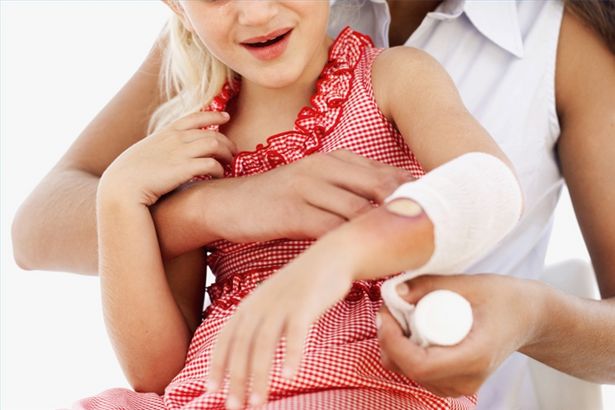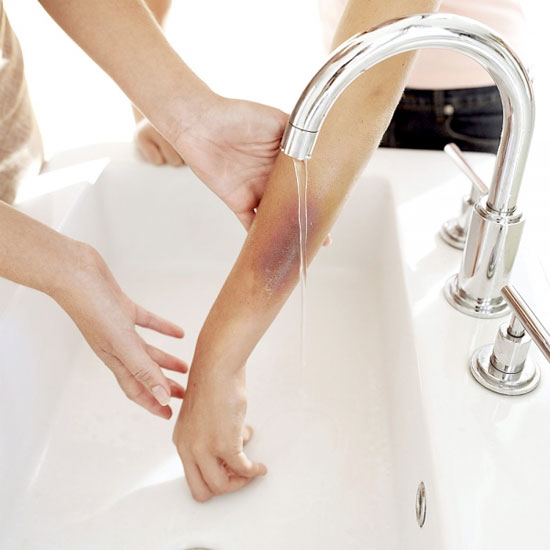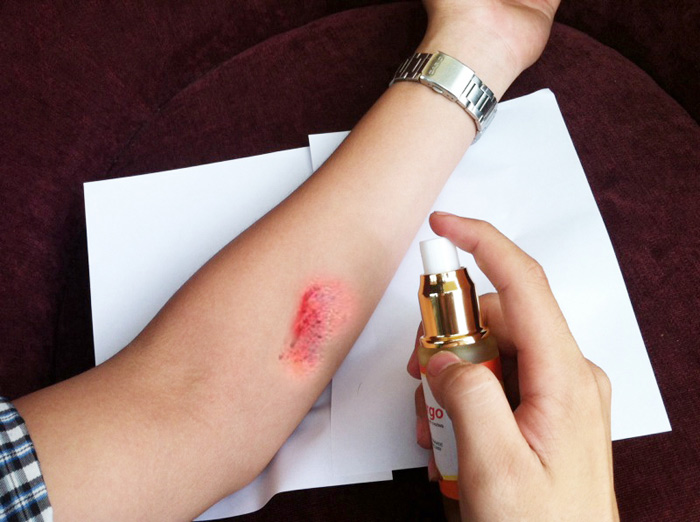The first aid for burns
Burns are accidents that are easy to encounter with just a small mistake. There are many causes of burns such as burns caused by fire, heat, chemicals . Depending on each cause of burns, we have a first aid and treatment of various burns to avoid dangerous health complications. patient.

Depending on the burner's agent, we will have a reasonable first aid.
The state of the body when burned depends on three factors:
- Depth of burns.
- Area of burns.
- Location of burns on the body.
1. Depth of burns
Burns are classified by depth into 3 degrees:
1.1 Degrees I: Surface burns
In this case, only the outer layer of the damaged skin causes the skin where the burns are red and irritation due to irritated nerves. This type of burn usually heals after 3 days.
1.2. Grade II: Partial burns of skin
In this case, the epidermis and part of the dermis layer are damaged, the water-repellent pouches are formed, if the water-repellent pouches are formed, if the vesicles emit burst water, it will reveal a pink surface. and also very painful. If the burn is kept clean, it will heal itself after about 1-4 weeks without any treatment and it will not leave a scar or scar but not significant. But skin organization after healing burns may be red for a longer time. If the second-degree burn is infected, the lower layer of skin will be destroyed and the second-degree burn will turn into Grade III burns.

For partial burns, if the burn is kept clean, it will heal itself after about 1-4 weeks without any treatment, without scarring.
1.3. Grade III
Whole skin burns : All skin layers are damaged including pores and sweat glands. Burns are pale or gray, dry and loss of sensation (painless) and nerve endings are destroyed.
In the case of very severe burns of all skin layers, the subcutaneous fat layer may also be destroyed and reveal muscle mass.
When the entire layer of the skin burns, the burn will only heal from the shore of the burns and the burns are very susceptible to infection so the healing time of the burn usually lasts very long.
The depth of a burn is sometimes uneven because the depth of the burn depends on the temperature, chemical concentration . and the time that the temperature or chemicals affect the skin. The skin tends to hold heat and the clothes are burnt to make the wound become heavier, so using too much water to wash the burn when the burn has just occurred (within 30 minutes when Accident occurrence) will work to reduce the depth of burns.
2. Area of burns
There are many ways to estimate the area of burns but usually the area of burns is calculated using the number 9 rule.
The larger the burn, the more dangerous it is because the larger the burn, the more fluid it can cause, causing more pain, more shock and infection. For adults with burns of 15% or more and children 10% or more must be considered severe burns and must be transferred to the hospital.
 The bigger the burn, the more dangerous it is.
The bigger the burn, the more dangerous it is.
3. Location of burns on the body
Burns in different areas also have great implications for life and recovery process.
For example:
- Burns on the face and neck can cause insertion of the airway, which is prone to bad scarring and distortion.
- Eye burns can lead to blindness.
- Burns in the hands or areas of the joints can lead to spasticity, loss or loss of function .
- Burns in the back, genital area and areas near the anus are often at high risk of infection, prolonging the healing time of burns.
- If the victim inhales smoke, the heat can cause respiratory tract burns to cause respiratory irritation, causing blockage leading to respiratory failure and very easily lead to pneumonia .
4. Emergency care in general
4.1. Extinguish the burning fire on clothes and cool the burn
This is the first job to prevent the victim from getting deep and extensive burns.
- Use water or sand to extinguish the fire, or you can use a jacket, a cloth, a cloth covered with a fire to put out the fire (do not use plastic or nylon to put out the fire).
- Tear away the smoldering piece of clothing or soaked in hot water, oil or chemical solutions if immediately without cold water to bounce off the burn area.
- Cover the burn area firmly and pour cold water over it. With hand burns, water from the tap water can flow directly into the burn area or soak the burned limb in cold water on the burn area but must be replaced every 3-4 minutes until the victim feel less painful.
- Remove hard objects from burns such as shoes, boots, rings before the swelling swells.
- Cover burn area with gauze, sterile cloth if available or with clean gauze or cloth.

How to handle fire burns.
Note: Never:
- Use ice to cool the burn or immerse your body in the water.
- Remove the burnt clothes that have been cooled.
- Touch the burn.
4.2. Shock prevention
- Put the victim in a lying position.
- Motivate to comfort the victim.
- Give the victim water to drink because the victim is very thirsty, especially when he has to move the victim away.
Attention:
- Only give the victim water to drink when the victim is alert, does not vomit and no other injuries.
- Oral solution: If possible, prepare the following solution to allow the victim to drink.
Mix in 1 liter of water:
+ 1/2 teaspoon salt.
+ 1/2 teaspoon of sodium bicarbonate salt.
2-3 teaspoons of sugar or honey, orange juice, lemon juice.
If there is no condition to prepare the solution, then the victim may drink sugar tea or oreson .
- Use painkillers for victims, take aspirin.
When using painkillers, care should be taken if you suspect that the victim has an internal injury, you should not use pain relievers or strong sedatives.
- Quickly transfer victim to treatment facility as soon as possible.
4.3. Maintain airway
The victim suffered burns in the face of the neck, especially when trapped in a burning house where there was oil, furniture, tables and chairs, burning flames . it would quickly suffer from facial and neck edema and complications of the road. respiration due to inhalation of fumes. These cases must be the first priority and must be transferred to the hospital immediately. But while waiting to monitor the victim closely and to ensure the escape of the respiratory tract (keep the correct posture or can put a canul in the nose or mouth of the victim, there are cases where the windpipe must be opened .) .
4.4. Prevention of infection
The burn itself is sterile. Therefore, in case of emergency, the burns must be very careful to avoid contaminated burns: do not use unclean water to flush or cover the burn and have the condition that an emergency worker should wash his hands and avoid touching the burn.
4.5. Burn
- Do not apply grease, alcohol solution even antibiotic cream to the burn.
- Do not poke water emulsion bags
- Do not peel off the skin or piece of clothing that sticks to the burn
- If possible, cover with a sterile gauze or else use cloth as clean as possible.
- The burn will drain a lot of fluid, so before using the scalp to use the burn again, a cotton pad should be padded on the gauze or cloth covered with the burn.

When dressing a burn, it should be covered with elastic bandage.
Note: If there is no elasticity, only loose the burn area to prevent the swelling of the swelling causing compression.
- If you burn your hands, you can put your hands in a plastic bag and then loosen your wrists, doing so will allow you to move your fingers easily while avoiding scratching the burn.
- If the burn is on the wrist or leg, first cover the burn with sterile gauze or a clean cloth and then put it in a plastic bag. Fixed limb splint can be placed, but in any case, it is necessary to raise burned limbs to prevent swelling of the toes and fingers and to advise victims to exercise early toes and fingers if available can be.
5. Emergency treatment of some special burns
5.1. Electric burns
Electric shock or lightning strikes can cause very deep burns, some patients suffer from electric burns, the body will also have cardiac arrest due to the current hitting the heart, so emergency treatment should be immediately stopped if the victim has stopped the heart first. First aid for the following burn. But before carrying out the burn, must:
- Power off.
- If the power cannot be disconnected, the victim must be removed from contact with electricity (must use an insulator: Rubber, dry wooden sticks to remove or pull the victim).
- When giving a first aid to a burn, it is necessary to quickly send the victim to the hospital immediately because patients with electrocution are more likely to have cardiovascular disorders.

When giving a first aid to a burn, quickly transfer the victim to the hospital immediately.
5.2. Chemical burns
Some chemicals like acid, strong alkaline or iodine, phosphorus used in industry or new lime can cause severe burn injuries and make victims very painful; with severe burns and very painful victims of chemical burns:
- Wash immediately, wash continuously with water as much as possible, otherwise organizations in the burn area will be completely necrotic.
If the cause of burn is determined by acid, wash the burn with water with bicarbonate phase. If the burn is caused by alkaline, wash with water mixed with vinegar and lemon. But if the eye burns due to chemicals, only wash with normal water. If there are still small particles of lime in the eye, it must be thoroughly washed to turn the lime particles out.
- Immediately remove clothes that are contaminated with chemicals.When removing it, take care to protect the hand of the person doing the gesture (do not use your bare hands to remove).
- If the burn burns heavily, it must be treated like a bleeding wound.
- Immediately transfer the victim to the treatment facility.
Emergency burns are simply not complicated, but require urgent, flexible emergency. A skilled emergency person can avoid many dangerous complications for the victim. 70% of burns that are kept clean will naturally heal. Many severe burns, large burns but were rescued and left insignificant sequelae thanks to the emergency and good first aid care.
- Quick treatment of burns without scarring
- First aid steps for burns in children
- Treatment for cold burns
- A lot of children suffer burns because of careless adults
- New method to treat burns without scarring
- New method: Cure burns with tilapia skin
- How to give emergency first aid to people suffering from acid burns
- Note to avoid burns when baking food with alcohol
- Does aloe really heal burns?
- Russia produces artificial skin for burns and eye diseases
- How dangerous is a respiratory burn?
- The big tree trunk burned from within
 Green tea cleans teeth better than mouthwash?
Green tea cleans teeth better than mouthwash? Death kiss: This is why you should not let anyone kiss your baby's lips
Death kiss: This is why you should not let anyone kiss your baby's lips What is salmonellosis?
What is salmonellosis? Caution should be exercised when using aloe vera through eating and drinking
Caution should be exercised when using aloe vera through eating and drinking